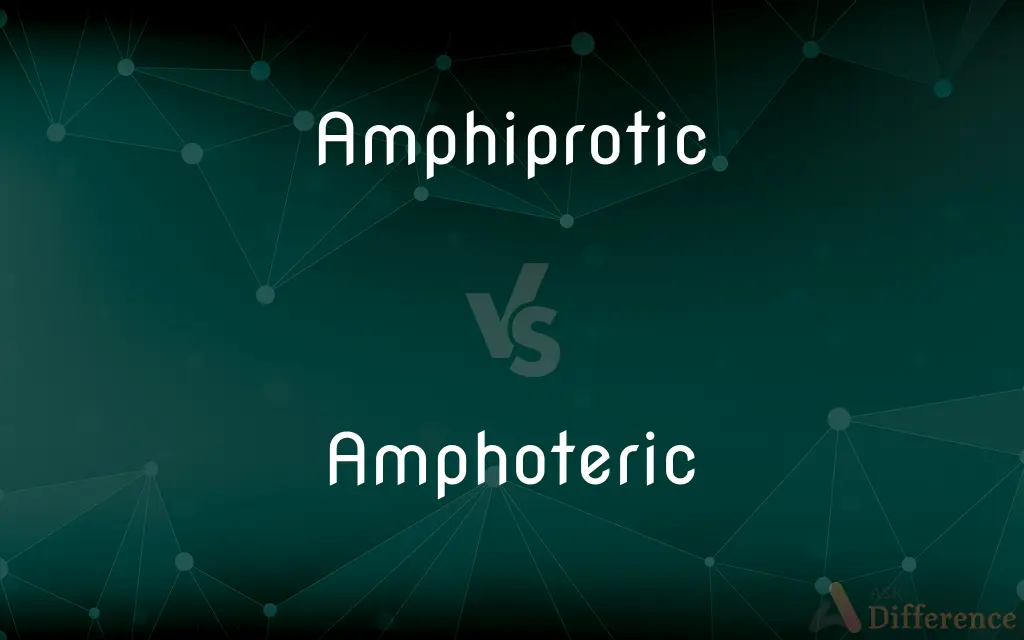Amphiprotic vs. Amphoteric — What's the Difference?
By Maham Liaqat & Urooj Arif — Updated on March 14, 2024
Amphiprotic substances can donate and accept protons in reactions, typical of specific solvents and ions, while amphoteric substances, broader in scope, act as both acids and bases, reacting with acids and bases.

Difference Between Amphiprotic and Amphoteric
Table of Contents
ADVERTISEMENT
Key Differences
Amphiprotic substances specifically have the ability to both donate and accept protons (H⁺ ions), making them a subset of amphoteric substances, which include any chemical species capable of reacting as either an acid or a base. For example, water is amphiprotic because it can donate a proton to become OH⁻ and accept a proton to become H₃O⁺, showcasing a behavior specific within the Brønsted-Lowry acid-base theory. On the other hand, amphoteric substances, such as zinc oxide (ZnO), not only include those that can donate and accept protons but also those that can react with both acids and bases by other mechanisms, fitting into the broader Lewis acid-base theory. This distinction means that while all amphiprotic substances are amphoteric, not all amphoteric substances are amphiprotic.
The concept of amphiproticity is especially relevant in the context of solvent systems and specific ions in aqueous solutions, such as bicarbonate (HCO₃⁻), which plays a crucial role in buffering solutions. In contrast, the amphoteric nature of a substance like aluminum hydroxide (Al(OH)₃) involves its ability to react with acids to form salts and water or with bases to form complexes, demonstrating a broader range of chemical behavior.
The identification of a substance as amphiprotic or amphoteric affects how it is utilized in chemical synthesis and analysis. Amphiprotic substances are often used in buffering solutions to maintain pH stability, whereas amphoteric substances can be crucial in processes like precipitation and complex formation reactions.
This distinction also plays a significant role in understanding biochemical processes and environmental chemistry, where the behavior of substances as acids or bases can influence reaction pathways, solubility, and metal ion availability in biological and ecological systems.
Comparison Chart
Definition
Can donate and accept protons
Can act as either acid or base
ADVERTISEMENT
Acid-Base Theory
Brønsted-Lowry
Lewis and Brønsted-Lowry
Examples
Water, bicarbonate (HCO₃⁻)
Zinc oxide (ZnO), aluminum hydroxide (Al(OH)₃)
Chemical Behavior
Proton transfer
Proton transfer and other reactions
Application
Buffer solutions, solvent systems
Precipitation, complex formation
Scope
Subset of amphoteric substances
Includes amphiprotic substances
Reaction with Acids/Bases
Yes, as donor or acceptor
Yes, forming salts or complexes
Compare with Definitions
Amphiprotic
Found in solvent systems and specific ions.
The amphiprotic nature of bicarbonate helps in pH regulation.
Amphoteric
Reacts as both acid and base.
Zinc oxide is amphoteric. reacting with both HCl and NaOH.
Amphiprotic
A substance that participates in proton transfer reactions.
Ammonia is amphiprotic in certain reactions.
Amphoteric
Participates in various chemical reactions.
Amphoteric substances like Al(OH)₃ react with acids and bases.
Amphiprotic
A characteristic of certain molecules and ions.
HS⁻ is amphiprotic. reacting with both acids and bases.
Amphoteric
Used in manufacturing and synthesis.
Amphoteric surfactants are key in cosmetic formulations.
Amphiprotic
Capable of donating and accepting protons.
Water is amphiprotic. acting as an acid or base.
Amphoteric
Includes a wider range of substances.
Aluminum hydroxide is an amphoteric compound used in water treatment.
Amphiprotic
Involved in buffering capacity.
Amphiprotic substances like acetic acid are used in buffers.
Amphoteric
Characterizes metals and metalloids.
Lead oxide is amphoteric. displaying varied chemical behavior.
Amphiprotic
(chemistry) Able to both donate and accept a proton, and thus able to react both as an acid and a base; amphoteric.
Amphoteric
Having the characteristics of an acid and a base and capable of reacting chemically either as an acid or a base.
Amphiprotic
Having characteristics of both an acid and a base and capable of reacting as either
Amphoteric
(chemistry) Having the characteristics of both an acid and a base, and capable of reacting as either; amphiprotic.
Amphoteric
Partly one and partly the other; neither acid nor alkaline; neutral.
Amphoteric
Relating to or containing an alkali; having a pH greater than 7;
Alkaline soils derived from chalk or limestone
Common Curiosities
What makes a substance amphiprotic?
Its ability to both donate and accept protons in chemical reactions.
Are all amphiprotic substances also amphoteric?
Yes, amphiprotic substances are a specific type of amphoteric substances.
What is an example of an amphiprotic substance?
Water (H₂O) is a classic example, capable of acting as both an acid and a base.
How does the concept of amphoteric differ in chemistry?
It refers to a broader category of substances that can exhibit dual behavior as acids or bases, beyond proton transfer.
What is a practical application of amphoteric substances?
They are used in industrial processes, such as metal extraction and water treatment, due to their reactive versatility.
Why is the distinction between amphiprotic and amphoteric important?
Understanding their differences helps in predicting the behavior of substances in various chemical environments.
Can an amphoteric substance react with both acids and bases?
Yes, amphoteric substances can react with acids to form salts and with bases to form complexes or neutralize them.
What role do amphiprotic substances play in buffering solutions?
They help maintain a stable pH by reacting with added acids or bases.
Are there any environmental implications of amphoteric behavior?
Yes, the reactivity of amphoteric substances with acids and bases can impact soil chemistry and aquatic ecosystems.
What is a Lewis acid or base?
A Lewis acid is an electron pair acceptor, while a Lewis base is an electron pair donor, expanding the definition of acids and bases beyond proton transfer.
How do amphiprotic and amphoteric substances differ in acid-base reactions?
Amphiprotic substances specifically engage in proton transfer, while amphoteric substances may undergo a wider range of acid-base reactions.
Can amphoteric substances be used in environmental chemistry?
Yes, they play significant roles in controlling pollution and treating water.
How do amphiprotic substances interact in biochemical systems?
They are crucial in metabolic pathways and enzyme functions due to their proton transfer capabilities.
What is the significance of aluminum hydroxide being amphoteric?
Its ability to react with both acids and bases makes it useful in antacids and as a flocculant in water treatment.
How does amphiproticity affect solubility?
Amphiprotic substances can influence the solubility of compounds in water by affecting the pH of the solution.
Share Your Discovery

Previous Comparison
Shareholder vs. Stockholder
Next Comparison
Soldier vs. PoliceAuthor Spotlight
Written by
Maham LiaqatCo-written by
Urooj ArifUrooj is a skilled content writer at Ask Difference, known for her exceptional ability to simplify complex topics into engaging and informative content. With a passion for research and a flair for clear, concise writing, she consistently delivers articles that resonate with our diverse audience.
















































